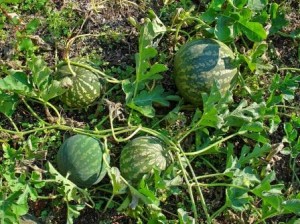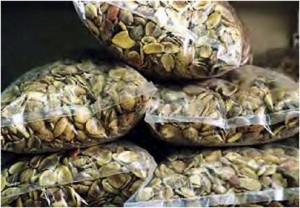Egusi, a wild member of the gourd family, has the potential to spread its popularity on the global market nearly as quickly as it grows. Native to parts of Western Africa, this peculiar looking plant can grow just about anywhere, from humid gullies, to dry savannahs, to tropical highlands – making it possible source of food for farmers in even the worst conditions.

Although the egusi looks almost identical to its cousin, the watermelon, don’t be fooled, they are actually quite different. (Photo credit: H. Zell)
Although the egusi looks almost identical to its cousin, the watermelon, don’t be fooled, they are actually quite different. Because the egusi is filled with very dry, bitter flesh, the seeds are the true delicacy of this melon. Composed of nearly 50 percent edible oil and another 30 percent pure protein, these little seeds pack a lot of nutrition into a very small package. In many parts of Africa, where farmers lack access to meat or dairy, the high oil and protein content can make an excellent dietary supplement.
While the seeds are often shelled and eaten individually as a snack, many processed forms of the seeds have made their way into common cooking practices. After soaking, fermenting, or boiling, the seeds take on different flavors and are frequently added to thicken soups and stews. On their own, the seeds can also be roasted and ground into a spread like peanut butter. With further preparation, egusi-seed meal can be pressed into patties to be used like a meat substitute, and its oil can be used for cooking.

Composed of nearly 50 percent edible oil and another 30 percent pure protein, these little seeds pack a lot of nutrition into a very small package. (Photo credit: Honoré Tabuna)
The egusi plant is also easy to grow. It is extremely resilient to pests and diseases and because it blankets the ground as it grows, it can help suppress weeds. Because of this, farmers often intercrop egusi with other crops, including sorghum, cassava, coffee, cotton, maize, or bananas. Mature egusi melons can also remain in the field for a long time without rotting, so crop loss and waste is rare. And once the seeds are harvested, they can be a reliable year-round food source because they store well.
The egusi can also be an important supplementary baby food, helping prevent malnutrition. Blending the seeds with water and honey produces a milky liquid that can be used as formula if breast milk is unavailable, making the plant as diverse in its uses as it is easy to grow!
To learn more about vegetables indigenous to Africa, read Native African Vegetables Could Help Solve Food Crises, Traditional Food Crops Provide Community Resilience in Face of Climate Change, Kenyan Professor Promotes Indigenous Food to Solve Climate Change Food Crisis, Amaranth: Food Production Without Attention, Pigeonpea: A Little Crop That’s Come a Long Way, and Celosia: Nature’s Prettiest Vegetable
Prepared by Elena Davert, Research Intern with the Nourishing the Planet Project.

Danielle Nierenberg, an expert on livestock and sustainability, currently serves as Project Director of State of World 2011 for the Worldwatch Institute, a Washington, DC-based environmental think tank. Her knowledge of factory farming and its global spread and sustainable agriculture has been cited widely in the New York Times Magazine, the International Herald Tribune, the Washington Post, and
other publications.
Danielle worked for two years as a Peace Corps volunteer in the Dominican Republic. She is currently traveling across Africa looking at innovations that are working to alleviate hunger and poverty and blogging everyday at Worldwatch Institute’s Nourishing the Planet. She has a regular column with the Mail & Guardian, the Kansas City Star, and the Huffington Post and her writing was been featured in newspapers across Africa including the Cape Town Argus, the Zambia Daily Mail, Coast Week (Kenya), and other African publications. She holds an M.S. in agriculture, food, and environment from Tufts University and a B.A. in environmental policy from Monmouth College.








